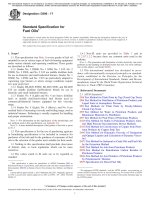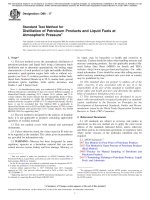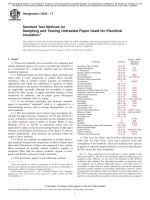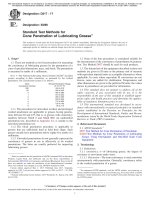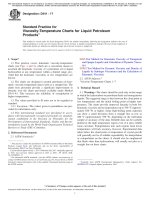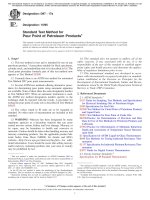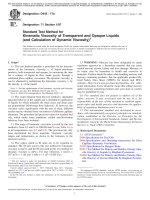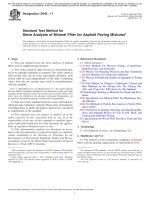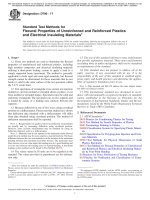Astm d 5853 17
Bạn đang xem bản rút gọn của tài liệu. Xem và tải ngay bản đầy đủ của tài liệu tại đây (216.66 KB, 11 trang )
This international standard was developed in accordance with internationally recognized principles on standardization established in the Decision on Principles for the
Development of International Standards, Guides and Recommendations issued by the World Trade Organization Technical Barriers to Trade (TBT) Committee.
Designation: D5853 − 17
Designation: 441/99 (2004)
Standard Test Method for
Pour Point of Crude Oils1
This standard is issued under the fixed designation D5853; the number immediately following the designation indicates the year of
original adoption or, in the case of revision, the year of last revision. A number in parentheses indicates the year of last reapproval. A
superscript epsilon (´) indicates an editorial change since the last revision or reapproval.
mendations issued by the World Trade Organization Technical
Barriers to Trade (TBT) Committee.
1. Scope*
1.1 This test method covers two procedures for the determination of the pour point temperatures of crude oils down to
−36 °C. Procedure A provides a measure of the maximum
(upper) pour point temperature and is described in 9.1. Procedure B provides a measure of the minimum (lower) pour point
temperature and is described in 9.2.
2. Referenced Documents
2.1 ASTM Standards:2
D97 Test Method for Pour Point of Petroleum Products
D130 Test Method for Corrosiveness to Copper from Petroleum Products by Copper Strip Test
D323 Test Method for Vapor Pressure of Petroleum Products
(Reid Method)
D4057 Practice for Manual Sampling of Petroleum and
Petroleum Products
D4177 Practice for Automatic Sampling of Petroleum and
Petroleum Products
D7962 Practice for Determination of Minimum Immersion
Depth and Assessment of Temperature Sensor Measurement Drift
E1 Specification for ASTM Liquid-in-Glass Thermometers
E77 Test Method for Inspection and Verification of Thermometers
E1137 Specification for Industrial Platinum Resistance Thermometers
E2251 Specification for Liquid-in-Glass ASTM Thermometers with Low-Hazard Precision Liquids
E2877 Guide for Digital Contact Thermometers
1.2 The use of this test method is limited to use for crude
oils. Pour point temperatures of other petroleum products can
be determined by Test Method D97.
1.3 The values stated in SI units are to be regarded as
standard. No other units of measurement are included in this
standard.
1.4 WARNING—Mercury has been designated by many
regulatory agencies as a hazardous material that can cause
central nervous system, kidney, and liver damage. Mercury, or
its vapor, may be hazardous to health and corrosive to
materials. Caution should be taken when handling mercury and
mercury-containing products. See the applicable product Material Safety Data Sheet (MSDS) for details and EPA’s
website— additional information. Users should be aware that selling mercury
and/or mercury containing products in your state or country
may be prohibited by law.
1.5 This standard does not purport to address all of the
safety concerns, if any, associated with its use. It is the
responsibility of the user of this standard to establish appropriate safety and health practices and determine the applicability of regulatory limitations prior to use. For specific hazard
statements, see Section 7.
1.6 This international standard was developed in accordance with internationally recognized principles on standardization established in the Decision on Principles for the
Development of International Standards, Guides and Recom-
3. Terminology
3.1 Definitions of Terms Specific to This Standard:
3.1.1 digital contact thermometer (DCT), n—an electronic
device consisting of a digital display and associated temperature sensing probe.
3.1.1.1 Discussion—This device consists of a temperature
sensor connected to a measuring instrument; this instrument
measures the temperature-dependent quantity of the sensor,
computes the temperature from the measured quantity, and
provides a digital output. This digital output goes to a digital
display and/or recording device that may be internal or external
1
This test method is under the jurisdiction of ASTM Committee D02 on
Petroleum Products, Liquid Fuels, and Lubricants and is the direct responsibility of
Subcommittee D02.07 on Flow Properties.
Current edition approved May 1, 2017. Published May 2017. Originally
approved in 1995. Last previous edition approved in 2016 as D5853 – 16. DOI:
10.1520/D5853-17.
2
For referenced ASTM standards, visit the ASTM website, www.astm.org, or
contact ASTM Customer Service at For Annual Book of ASTM
Standards volume information, refer to the standard’s Document Summary page on
the ASTM website.
*A Summary of Changes section appears at the end of this standard
Copyright © ASTM International, 100 Barr Harbor Drive, PO Box C700, West Conshohocken, PA 19428-2959. United States
1
D5853 − 17
NOTE 1—All dimensions are stated in millimetres. Positioning of temperature sensing devices are shown in the figure.
FIG. 1 Apparatus for Pour Point Test
5.3 The maximum and minimum pour point temperatures
provide a temperature window where a crude oil, depending on
its thermal history, might appear in the liquid as well as the
solid state.
to the device. These devices are sometimes referred to as a
“digital thermometer.”
3.1.1.2 Discussion—PET is an acronym for portable electronic thermometers, a subset of digital contact thermometers
(DCT).
3.1.2 maximum (upper) pour point, n—the pour point obtained after the test specimen has been subjected to a prescribed treatment designed to enhance gelation of wax crystals
and solidification of the test specimen.
3.1.3 minimum (lower) pour point, n—the pour point obtained after the test specimen has been subjected to a prescribed treatment designed to delay gelation of wax crystals
and solidification of the test specimen.
3.1.4 pour point, n—the lowest temperature at which movement of the test specimen is observed under the conditions of
the test.
5.4 The test method can be used to supplement other
measurements of cold flow behavior. It is especially useful for
the screening of the effect of wax interaction modifiers on the
flow behavior of crude oils.
6. Apparatus
6.1 Pour Point Test Apparatus Assembly (see Fig. 1):
6.1.1 Test Jar, cylindrical, of clear glass, flat bottomed,
outside diameter 33.2 mm to 34.8 mm, and height 115 mm to
125 mm. The inside diameter of the jar can range from
30.0 mm to 32.4 mm, within the constraint that the wall
thickness shall be no greater than 1.6 mm. The jar shall have a
line to indicate a sample height 54 mm 6 3 mm above the
inside bottom. The inside of the test jar (up to the mark) shall
be visibly clean and free of scratches.
6.1.2 Temperature Measuring Device—Either liquid-inglass thermometer as described in 6.1.2.1 or digital contact
thermometer (DCT) meeting the requirements described in
6.1.2.3 and 6.1.2.4.
6.1.2.1 Liquid-in-Glass Thermometers, having ranges
shown in the following table and conforming to the requirements prescribed in Specification E1 or Specification E2251
for thermometers:
4. Summary of Test Method
4.1 After preliminary heating, the test specimen is cooled at
a specified rate and examined at intervals of 3 °C for flow
characteristics. The lowest temperature at which movement of
the test specimen is observed is recorded as the pour point.
5. Significance and Use
5.1 The pour point of a crude oil is an index of the lowest
temperature of handleability for certain applications.
5.2 This is the only pour point method specifically designed
for crude oils.
2
D5853 − 17
Thermometer
Thermometer
High cloud and pour
Low cloud and pour
Melting point
Temperature Range
−38 °C to +50 °C
−80 °C to +20 °C
+32 °C to +127 °C
Number
ASTM
5C, S5C
6C
61C
Length of Sheath in Sample
Tip of sheath between 10 mm and 15 mm
below sample meniscus (Fig. 1).
Accuracy
±500 mK (±0.5 °C) for combined probe and
sensor
Response Time
Less than or equal to 25 s as defined in
Specification E1137
Drift
Less than 500 mK (0.5 °C) per year
Calibration Error
Less than 500 mK (0.5 °C) over the range of
intended use.
Calibration Range
32 °C or lower to 130 °C
Calibration Data
4 data points evenly distributed over calibration range with data included in calibration
report.
Calibration Report
From a calibration laboratory with demonstrated competency in temperature calibration which is traceable to a national calibration laboratory or metrology standards body.
IP
1C
2C
63C
6.1.2.2 Since separation of liquid column thermometers
occasionally occurs and may escape detection, the ice point of
the thermometers shall be checked prior to the test and used
only if they are accurate within 61 °C (see Test Method E77).
6.1.2.3 Digital contact thermometer requirements for pour
point:3
Parameter
DCT
Requirement
Guide E2877 Class G or better
Temperature Range
–80 °C to 50 °C
Display Resolution
0.1 °C minimum
Sensor Type
Platinum Resistance Thermometer (PRT)
Sensor
3 mm o.d. sheath with a sensing element
less than 10 mm in length
Minimum Immersion
Less than 40 mm per Practice D7962
Length of Sheath in Sample
Tip of sheath between 10 mm and 15 mm
below sample meniscus (Fig. 1).
Accuracy
±500 mK (±0.5 °C) for combined probe and
sensor
Response Time
Less than or equal to 25 s as defined in
Specification E1137
Drift
Less than 500 mK (0.5 °C) per year
Calibration Error
Less than 500 mK (0.5 °C) over the range of
intended use.
Calibration Range
–40 °C or lower to 50 °C
Calibration Data
4 data points evenly distributed over calibration range with data included in calibration
report.
Calibration Report
From a calibration laboratory with demonstrated competency in temperature calibration which is traceable to a national calibration laboratory or metrology standards body.
NOTE 1—When the DCT display is mounted on the end to the probe’s
sheath, the test jar with the probe inserted will be unstable. To resolve this,
it is recommended that the probe be between 15 cm and 30 cm in length.
A 5 cm long stopper that has a low thermal conductivity with approximately half of it inserted in the sample tube will improve stability.
6.1.2.5 The DCT calibration drift shall be checked at least
annually by either measuring the ice point or against a
reference thermometer in a constant temperature bath at the
prescribed immersion depth to ensure compliance with 6.1.2.3
or 6.1.2.4. See Practice D7962.
NOTE 2—When a DCT’s calibration drifts in one direction over several
calibration checks, it is an indication of a change in the DCT, thus a full
recalibration is necessary.
6.1.3 Cork, to fit the test jar, center bored for the test
thermometer.
6.1.4 Jacket, watertight, cylindrical, metal, flat bottomed,
115 mm 6 3 mm depth, with inside diameter of 44.2 mm to
45.8 mm. It shall be supported in a vertical position in the
cooling bath (6.1.7) so that no more than 25 mm projects out
of the cooling medium. The jacket shall be capable of being
cleaned.
6.1.5 Disk, cork or felt, 6 mm thick to fit loosely inside the
jacket.
6.1.6 Gasket, to fit snugly around the outside of the test jar
and loosely inside the jacket. The gasket shall be made of
rubber, leather, or other material that is sufficiently elastic to
cling to the test jar and hard enough to hold its shape. Its
purpose is to prevent the test jar from touching the jacket.
6.1.7 Cooling Bath or Baths, of a type suitable for obtaining
the required temperatures. The size and shape of the bath are
optional, but a support to hold the jacket firmly in a vertical
position is essential. The bath temperature shall be monitored
by means of the appropriate thermometer (6.1.2) or any other
temperature measuring device capable of measuring and displaying the designated temperature with the required precision
and accuracy. The required bath temperatures shall either be
obtained by refrigeration or by suitable cooling mixtures and
shall maintain the designated temperatures to within 61.5 °C.
Cooling mixtures commonly used for bath temperatures are
shown in Table 1.
6.1.2.4 Digital contact thermometer requirements for melting point:
Parameter
DCT
Requirement
Guide E2877 Class E or better
Temperature Range
32 °C to 130 °C
Display Resolution
0.1 °C minimum
Sensor Type
Platinum Resistance Thermometer (PRT)
Sensor
3 mm o.d. sheath with a sensing element
less than 24 mm in length
Minimum Immersion
Less than 40 mm per Practice D7962
3
Supporting data have been filed at ASTM International Headquarters and may
be obtained by requesting Research Report RR:D02-1826. Contact ASTM Customer
Service at
3
D5853 − 17
TABLE 1 Cooling Mixtures and Bath Temperatures
Bath Temperature
0 °C ± 1.5°C
Ice and water
Crushed ice and sodium chloride crystals or
Acetone or petroleum naphtha or methanol or ethanol
(see Section 7) with solid carbon dioxide added to
give the desired temperature
−18 °C ± 1.5°C
Acetone or petroleum naphtha or methanol or ethanol
(see Section 7) with solid carbon dioxide added to
give the desired temperature
–33 °C ± 1.5°C
Acetone or petroleum naphtha or methanol or ethanol
(see Section 7) with solid carbon dioxide added to
give the desired temperature
–51 °C ± 1.5°C
Acetone or petroleum naphtha or methanol or ethanol
(see Section 7) with solid carbon dioxide added to
give the desired temperature
–69 °C ± 1.5°C
8. Sampling, Test Samples, and Test Specimens
6.2 Water Bath—The size and shape of the bath are optional,
but a support to hold the test jar immersed in the bath to above
the sample height in the test jar and in a firm vertical position
is required. The required bath temperature may be maintained
by any suitable means, provided the temperature can be
monitored and controlled to the designated temperature (61 °C
(9.1.4; 9.2.4)).
NOTE 5—Sampling is defined as all steps required to obtain a portion of
the contents of any pipe, tank, or other system and to place the sample into
the laboratory test container.
8.1 Laboratory Sample—It is essential that the sample
received by the laboratory is representative of the batch or lot
of crude oil from which it was taken. Practices D4057 and
D4177 provide guidance for obtaining such representative
samples.
6.3 Pressure Vessel, constructed of stainless steel according
to the dimensions given in Fig. 2, and capable of withstanding
a test pressure of 700 kPa. Alternative designs for the pressure
vessel cap and synthetic rubber gasket may be used provided
that the internal dimensions of the pressure vessel are the same
as those shown in Fig. 2.
8.2 Preparation of Test Samples—The pour point of crude
oils is very sensitive to trace amounts of high melting waxes.
Exercise meticulous care to ensure such waxes, if present, are
either completely melted or, if volatility constraints prevent
heating to complete melting, homogeneously suspended in the
sample (Appendix X1). Inspect the walls of the original
container to ensure that no high melting point material is left
sticking to the wall.
NOTE 3—This pressure vessel is identical to the pressure vessel
described in Test Method D130.
6.4 Timing Device, capable of measuring up to 30 s with a
resolution of at least 0.1 s and an accuracy of 60.2 s or better.
NOTE 6—It is not possible to define universal mandatory rules for the
preparation of crude oil test samples. Guidelines for sample handling for
the most common situations are given in Appendix X1.
7. Reagents and Materials
7.1 The following solvents of technical grade are appropriate for low-temperature bath media.
7.1.1 Acetone, (Warning—Extremely flammable.)
7.1.2 Petroleum Naphtha, (Warning—Combustible. Vapor
harmful.)
9. Procedure
9.1 Procedure A for Maximum (Upper) Pour Point:
9.1.1 Pour the test sample into the test jar to the level mark.
If necessary, reheat the test sample to a temperature at least
20 °C above the expected pour point (8.2 and Appendix X1)
but not higher than a temperature of 60 °C (Warning—The
vapor pressure of crude oils at temperatures higher than 60 °C
will usually exceed 100 kPa. Under these circumstances the
sample container may rupture. Opening of the container may
induce foaming with resultant loss of sample and possible
injury to personnel.)
9.1.2 Immediately close the test jar with the cork carrying
the high cloud and pour thermometer, or, if the expected pour
point is above 36 °C, the melting point thermometer. Adjust the
position of the cork and thermometer so the cork fits tightly, the
thermometer and the jar are coaxial, and the thermometer bulb
is immersed to a depth that places the beginning of the
capillary 3 mm below the surface of the test specimen.
9.1.3 Keep the test jar with the test specimen at room
temperature (between 18 °C and 24 °C) for at least 24 h.
NOTE 4—Typical petroleum naphtha used for cleaning purposes are VM
and P naphthas.
7.2 Toluene, technical grade (Warning—Flammable. Vapor
harmful.).
7.3 Solid Carbon Dioxide, (Warning—Extremely cold
(−78.5 °C).)
7.4 Sodium Chloride Crystals—Commercial or technical
grade sodium chloride is suitable.
7.5 Ethanol or Ethyl Alcohol—A commercial or technical
grade of dry ethanol is suitable for the cooling bath.
(Warning—Flammable. Denatured. Cannot be made nontoxic.)
7.6 Methanol or Methyl Alcohol—A commercial or technical grade of dry methanol is suitable for the cooling bath.
(Warning—Flammable. Vapor harmful.)
4
D5853 − 17
FIG. 2 Pressure Vessel
expected pour point is less than 36 °C, heat the sample to a
temperature of 45 °C 6 1 °C. Maintain the water bath (6.2) to
heat the sample at 48 °C 6 1 °C or at a temperature 12 °C
higher than the expected pour point, whichever is higher.
NOTE 7—The pour point of a crude oil is dependent on the state of
crystallization of the wax in the test specimen. In crude oils, achieving
equilibrium between crystallized wax and dissolved wax is a rather slow
process. However, experience has shown that in a majority of cases, such
an equilibrium is reached within 24 h. Especially when a DCT is used,
additional care must be taken to ensure that the thermometer does not
move in the sample during the test, so additional support elements will
likely be needed.
9.1.4 If the expected pour point is greater than 36 °C, heat
the sample to 9 °C above the expected pour point. If the
5
D5853 − 17
is held in a horizontal position for 5 s. Record the observed
reading of the test temperature.
9.1.8.1 If the test specimen has reached −36 °C and still
shows movement, discontinue the test.
9.1.4.1 As soon as the test specimen has reached the
required temperature, remove the cork carrying the thermometer and stir the test specimen gently with a spatula or similar
device. Put the cork carrying the thermometer back in place
(see 9.1.2).
9.1.5 Ensure that the disk, gasket, and the inside of the
jacket are clean and dry. Place the disk in the bottom of the
jacket. Place the disk and jacket in the cooling medium a
minimum of 10 min before the test jar is inserted. The use of
a jacket cover, while the empty jacket is cooling, is permitted.
Remove the test jar from the water bath and dry with a tissue.
Place the gasket around the test jar, 25 mm from the bottom.
Insert the test jar into the jacket in the first bath maintained at
21 °C and commence observations for pour point. Never place
a test jar directly into the cooling medium.
9.1.6 Exercise care not to disturb the mass of test specimen
nor permit the thermometer to shift in the test specimen; any
disturbance of the spongy network of wax crystals will lead to
a lower pour point and erroneous results (Note 7).
NOTE 9—To determine compliance with existing specifications having
pour point limits at temperatures not divisible by 3 °C, it is acceptable
practice to conduct the pour point measurement according to the following
schedule. Begin to examine the appearance of the test specimen when the
temperature of the test specimen is 9 °C above the specification pour
point. Continue observations at 3 °C intervals as described in 9.1.6 and
9.1.7 until the specification temperature is reached. Report the sample as
passing or failing the specification limit.
9.2 Procedure B for Minimum (Lower) Pour Point:
9.2.1 Pour 50 g of the test sample into a clean pressure
vessel (6.3 and Note 10). When necessary, reheat the test
sample to a temperature of at least 20 °C above the expected
pour point (8.2 and Appendix X1) but not higher than 60 °C
(Warning—The vapor pressure of crude oils at temperatures
higher than 60 °C will usually exceed 100 kPa. Under these
circumstances the sample container may rupture. Opening of
the container may induce foaming with resultant loss of sample
and possible injury to personnel.) Check that the rubber ring is
in place and screw the lid on tightly.
NOTE 8—With dark colored materials, such as crude oils, it is
impractical to observe, in the test jar, the onset of crystallization and
network formation in the test specimen. Hence, it is presumed that
network formation will begin at the very early stages of the cooling
sequence.
NOTE 10—The pressure vessel may be cleaned by any appropriate
solvent, provided the solvent is capable of dissolving remnants of high
melting wax and asphaltenes. Hot toluene (100 °C) has been found to be
an appropriate solvent for this purpose.
9.1.7 Pour points are expressed in temperatures which are
positive or negative multiples of 3 °C. Begin to examine the
appearance of the test specimen when the temperature of the
test specimen is 9 °C above the expected pour point (estimated
as a multiple of 3 °C). At each test thermometer reading which
is a multiple of 3 °C below the starting temperature, remove
the test jar from the jacket. When necessary, remove moisture
that limits visibility of the test specimen by wiping the surface
of the test jar with a clean cloth moistened in alcohol at
approximately the temperature of the test specimen in the jar.
Then tilt the jar just enough to ascertain whether there is
movement of the test specimen in the jar. When movement is
observed, immediately return the test jar into the jacket. If
movement of the specimen in the test jar is noted, then replace
the test jar immediately in the jacket, and repeat a test for flow
at the next temperature, 3 °C lower. Typically the complete
operation of removal, wiping, and replacement shall require
not more than 3 s.
9.1.7.1 If the test specimen has not ceased to flow when its
temperature has reached 30 °C, transfer the test jar to the next
lower temperature bath per the following schedule:
(1) If the test specimen is at +30 °C, move to 0 °C bath;
(2) If the test specimen is at +9 °C, move to −18 °C bath;
(3) If the test specimen is at −9 °C, move to −33 °C bath;
and
(4) If the test specimen is at −24 °C, move to −51 °C bath.
9.1.7.2 If the test specimen in the jar does not show
movement when tilted, hold the jar in a horizontal position for
5 s, as shown by an accurate timing device (6.4), and observe
the specimen carefully. If the test specimen shows any movement before 5 s has passed, replace the test jar immediately in
the jacket, and repeat a test for flow at the next temperature,
3 °C lower.
9.1.8 Continue in this manner until a point is reached at
which the test specimen shows no movement when the test jar
9.2.2 Heat the pressure vessel in an oil bath or by any other
suitable means to a temperature of 105 °C 6 2 °C and leave at
that temperature for at least 30 min.
9.2.3 Take the pressure vessel from the oil bath, wipe and
dry the surface of the pressure vessel, swirl gently to homogenize the contents, and leave the pressure vessel to cool at
room temperature for exactly 20 min 6 30 s.
9.2.4 Carefully open the pressure vessel and transfer the
sample into the test jar filling to the level mark of the test jar,
preheated in a water bath (6.2) kept at a temperature of 48 °C
6 1°C (Warning—After 20 min at ambient temperature, the
temperature of the test specimen will be approximately 50 °C.
The vapor pressure at that temperature may still exceed
100 kPa. Under these circumstances, inattentive opening of the
pressure vessel may induce foaming with resultant loss of
sample and possible injury to personnel.)
9.2.5 Immediately close the test jar with the cork carrying
the high cloud and pour thermometer, or, if the expected pour
point is above 36 °C, the melting point thermometer. Adjust the
position of the cork and thermometer so the cork fits tightly, the
thermometer and the jar are coaxial, and the thermometer bulb
is immersed to a depth which places the beginning of the
capillary 3 mm below the surface of the test specimen.
9.2.6 Proceed as described in 9.1.5 – 9.1.8.
10. Calculation and Report
10.1 Add 3 °C to the temperature recorded in 9.1.8 and
report as Maximum Pour Point, ASTM D5853, Procedure A, or
Minimum Pour Point, ASTM D5853, Procedure B, if the
procedure in 9.2 has been followed.
6
D5853 − 17
the long run, in the normal and correct operation of the test
method, exceed the following value only in 1 case in 20.
10.2 If the test was discontinued (9.1.8.1), report the pour
point as ≤ −36 °C.
11. Precision and Bias
Procedure
A (max)
B (min)
11.1 The following criteria are to be used for judging the
acceptability of results (95 % confidence):
11.1.1 Repeatability—The difference between successive
test results obtained by the same operator with the same
apparatus under constant operating conditions on identical test
material would, in the long run, in the normal and correct
operation of the test method, exceed the following value only
in 1 case in 20.
Procedure
A (max)
B (min)
(3)
(6)
18.0
22.0
(18)
(21)
(Note 11)
(Note 11)
NOTE 11—These precision values are derived from a 1994 cooperative
program4 and the current Committee D02 Statistical Method, RR:D021007.5 The data in this study were obtained using liquid-in-glass thermometers.
11.2 Bias—The procedure in this test method has no bias
because the value of pour point is defined only in terms of this
test method.
Repeatability
°C
(rounded)
3.1
5.8
Reproducibility
°C
(rounded)
12. Keywords
12.1 cold flow; crude oil; pour point
(Note 11)
(Note 11)
4
Supporting data have been filed at ASTM International Headquarters and may
be obtained by requesting Research Report RR:D02-1371.
5
Supporting data have been filed at ASTM International Headquarters and may
be obtained by requesting Research Report RR:D02-1007.
11.1.2 Reproducibility—The difference between two, single
and independent results, obtained by different operators working in different laboratories on identical test material would, in
ANNEX
(Mandatory Information)
A1. THERMOMETER SPECIFICATIONS
A1.1 See Table A1.1.
7
D5853 − 17
TABLE A1.1 Thermometer Specifications
NOTE 1—The emergent stem temperature is 21 C throughout the scale range
NOTE 2—Thermometers IP 1C/ASTM 5C (high cloud and pour), and IP 63C/ASTM 61C (melting point) conform to these requirements.
Range
Immersion
Graduation at each
Longer lines at each
Figured at each
Scale error, max
Expansion chamber to permit heating to
Overall length
Stem diameter
Bulb length
Distance from bottom of bulb to line at
Length of scale
High cloud and pour
–38 to +50
108
1
5
10
0.5
100
230 ± 5
6 to 8
7 to 10
–38
120 to 130
65 to 85
°C
mm
°C
°C
°C
°C
°C
mm
mm
mm
°C
mm
mm
8
Melting point
32 to 127
79
0.2
1
2
0.2
150
380 ± 5
6 to 8
18 to 28
32
105 to 115
200 to 240
D5853 − 17
APPENDIX
(Nonmandatory Information)
X1. GUIDELINE FOR SAMPLE HANDLING
X1.1 Introduction
and, at the same time, is the most difficult to redissolve or
disperse in the crude oil. Proper treatment of the samples
before subsampling for pour point, therefore, is crucial for
obtaining reliable crude oil pour point results.
X1.1.1 Sampling of crude oils from pipelines, tankers,
barges, or trucks is usually beyond control of the laboratory
and adequately covered by the appropriate sampling protocols
as specified in Practices D4057 and D4177.
X1.2.2 In order to achieve complete solubility of the wax,
heat crude oil samples to a temperature above the wax cloud
point. This value is seldom known however. As a rule of
thumb, a temperature of 20 °C above the expected pour point
will usually satisfy the cloud point requirement, although
exceptions do occur.
X1.1.2 This guideline covers the sampling from containers
submitted to the analytical laboratory for analysis. It covers the
handling of samples between the point at which they were
extracted or drawn, and the laboratory test bench or sample
storage. It is meant to ensure that the nature and integrity of the
samples are maintained as far as possible.
X1.2.3 The vast majority of crude oils show a significant
vapor pressure even at ambient temperatures. Dead crude is
usually stabilized at a vapor pressure of 50 kPa (Test Method
D323, RVP at 37.8 °C) or below. However, occasionally, high
RVP crudes (80 kPa) are produced and marketed. Before
testing, never subject a crude oil sample to a temperature
higher than 60 °C or to a temperature above the bubble point
(vapor pressure ≥100 kPa). As a rule of thumb, the vapor
pressure doubles for every 20 °C increase in temperature.
X1.1.3 The method of handling a sample will depend on the
purpose for which it was taken. The laboratory analytical
procedure to be used will often require a special handling
procedure to be associated with it. For this reason, consult the
appropriate methods of test so that any necessary instructions
as to sample handling can be given to the person drawing the
sample. If the analytical procedures to be applied have conflicting requirements, as is often the case for crude oils, then
draw separate samples and apply the appropriate procedure to
each sample.
X1.3 Homogenization of Samples
X1.1.4 For crude oils, care in sampling is particularly
necessary because:
X1.1.4.1 They contain volatile material, hence loss by
evaporation can occur.
X1.1.4.2 They contain water or sediment, or both, which
tends to separate in the sample container.
X1.1.4.3 If not maintained at a sufficiently high
temperature, wax deposition at the walls of the container or
wax precipitation can occur.
X1.3.1 The proper means and effectiveness of mixing in
order to achieve homogeneity depend, in addition to the
physical properties (for example, viscosity) of the crude oil, on
the capacity and shape of the container in which the crude oil
arrives at the laboratory. It is virtually impossible to cater to
every possibility and achieve optimum results under all circumstances. Guidelines are provided which in actual practice
have proven to achieve the best possible results for the most
common situations.
X1.1.5 When making up composite samples, exercise care
not to lose light ends and to ensure homogeneity of the
composing samples.
X1.3.2 Drums, 15 L to 200 L—The most effective way of
achieving homogenization is mixing the contents of the drum
on a roller bank in a hot room kept at a temperature between
40 °C and 60 °C for 48 h (X1.2.3). Alternatively, keep the
drum at a temperature of 20 °C above the expected pour point
for 48 h (X1.2.3) and roll the drum for at least 15 min before
taking a sample. If heating of the drum is not feasible, the only
alternative is extensive rolling for at least 30 min to disperse
the wax and wax particles as effectively as possible. In order to
avoid the cumbersome procedure of (re)mixing the contents of
large sample containers, it is recommended to draw an adequate number of subsamples in smaller containers, using
Practice D4057 as a guide (X1.1.3 – X1.1.7). (Warning—
Before embarking on any heating or mixing procedure, or both,
ensure that the drum and plugs can withstand the expected
pressure build-up and can be handled safely without leakage.)
(Warning—Exercise care when opening the container, as
significant vapor pressure will have built up (X1.2.3). Opening
the container may induce foaming with resultant spillage of
sample and possible injury to personnel.)
X1.1.6 If crude oil samples are to be tested for vapor
pressure, density, or any other test in which retention of light
ends is essential, subsamples for these test methods shall be
taken first before any other sample handling procedures are
invoked for performing sampling for other tests such as pour
point.
X1.1.7 Never subsample crude oils in plastic containers or
any other container that will not retain gases or light materials
and cannot be heated without deformation.
X1.2 Heating of Samples
X1.2.1 Crude oils stored at temperatures below their cloud
point will show wax deposition on the walls of the (sample)
containers. The wax coming out of the solution will be
preferentially the high melting wax. It is this type of wax that
has the most pronounced influence on the crude oil pour point
9
D5853 − 17
buildup and can be handled safely without leakage.)
(Warning—Exercise care when opening the container, as
significant vapor pressure will have built up (X1.2.3). Opening
the container may induce foaming with resultant spillage of
sample and possible injury to personnel.)
X1.3.3 Tins, 1 L to 15 L—Store the container at a temperature 20 °C above the expected pour point (X1.2.1) preferably in
a water bath kept at the appropriate temperature. Alternatively,
store the container in an explosion-proof oven, bearing in mind
that local surface temperatures might be much higher than the
oven temperature reading indicates. The time required to
dissolve the wax will depend on the type of wax and the size
of the container. For a 1 L tin, 2 h has been found to be
adequate. For larger tins, longer times will be required.
Although it is strongly recommended that the containers be
closed when heated, it is advised that after approximately
30 min, the excess pressure is slowly released before continuing the heating. (Warning—Exercise care when opening the
container, as significant vapor pressure will have built up
(X1.2.3). Opening the container may induce foaming with
resultant spillage of sample and possible injury to personnel.)
Mixing can be accomplished by a mechanical shaker or by
vigorous manual shaking. Although the use of (high speed)
mixers or similar devices might be effective, it will require that
the container be open for some time, during which the escape
of light ends can be excessive, and hence, this procedure is not
recommended. (Warning—During this operation significant
amounts of highly flammable vapors might escape. Vent in a
safe area.)
X1.3.5 Plastic Containers—The use of plastic containers
for crude oil samples is strongly discouraged for a number of
reasons (X1.1.7). If such a container is offered to the
laboratory, however, the only way to handle these containers is
by heating to a temperature 20 °C above the expected pour
point (X1.2.1 – X1.2.3) in a water bath kept at the appropriate
temperature. The water bath prevents localized high temperatures in the container, which can create weak sections increasing the possibility of rupture. In any case, rupture of these
containers due to pressure buildup is a distinct possibility and
adequate measures must be taken to ensure safety. (Warning—
Exercise care when opening the container, as significant vapor
pressure will have built up (X1.2.3). Opening the container
may induce foaming with resultant spillage of sample and
possible injury to personnel.)
X1.3.6 Sample Receivers (Practice D4177)—Follow the
prescribed sample mixing and handling procedure as described
in Practice D4177. It is recommended that a 1 L (tin)
subsample be taken concurrently with subsampling for density
and water and sediment, provided that the sample receiver has
not been below the crude oil cloud point for more than 6 h. If
the container has been kept at a temperature below the cloud
point for more then 6 h, reheat the container to a temperature
20 °C above the expected pour point (X1.2.1 – X1.2.3) before
mixing and subsampling.
X1.3.4 Bottles—Follow as described in X1.3.3. Exercise
special care when heating bottles that are closed with a cork or
rubber stopper. The pressure buildup due to the heating will
inevitably blow out the stopper. Take proper measures to
safeguard against such an event. (Warning—Before embarking on any heating or mixing procedure, or both, ensure that the
bottles and closures can withstand the expected pressure
SUMMARY OF CHANGES
Subcommittee D02.07 has identified the location of selected changes to this standard since the last issue
(D5853 – 16) that may impact the use of this standard. (Approved May 1, 2017.)
(2) Added new Annex A1.
(1) Updated IP year date.
Subcommittee D02.07 has identified the location of selected changes to this standard since the last issue
(D5853 – 11) that may impact the use of this standard. (Approved Dec. 1, 2016.)
(1) Added requirements for DCT temperature measuring device.
(2) Reformatted units to conform to SI.
10
D5853 − 17
ASTM International takes no position respecting the validity of any patent rights asserted in connection with any item mentioned
in this standard. Users of this standard are expressly advised that determination of the validity of any such patent rights, and the risk
of infringement of such rights, are entirely their own responsibility.
This standard is subject to revision at any time by the responsible technical committee and must be reviewed every five years and
if not revised, either reapproved or withdrawn. Your comments are invited either for revision of this standard or for additional standards
and should be addressed to ASTM International Headquarters. Your comments will receive careful consideration at a meeting of the
responsible technical committee, which you may attend. If you feel that your comments have not received a fair hearing you should
make your views known to the ASTM Committee on Standards, at the address shown below.
This standard is copyrighted by ASTM International, 100 Barr Harbor Drive, PO Box C700, West Conshohocken, PA 19428-2959,
United States. Individual reprints (single or multiple copies) of this standard may be obtained by contacting ASTM at the above
address or at 610-832-9585 (phone), 610-832-9555 (fax), or (e-mail); or through the ASTM website
(www.astm.org). Permission rights to photocopy the standard may also be secured from the Copyright Clearance Center, 222
Rosewood Drive, Danvers, MA 01923, Tel: (978) 646-2600; />
11
